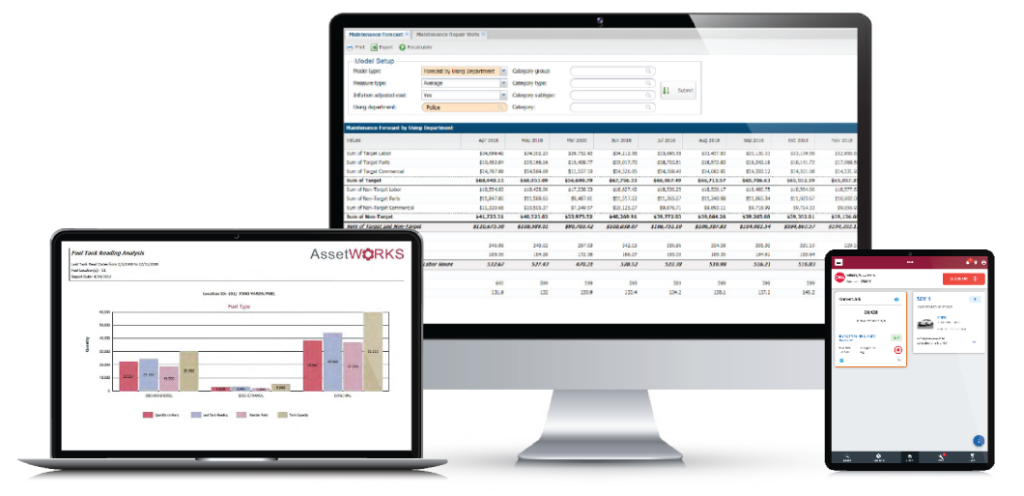The City of Austin, Texas, is not only the state’s capital but is ranked the 11th largest city in the United States- with a metropolitan area of over 1.5 million people. The growing city contains endless outdoor activities, vibrant entertainment, countless cuisines, arts and culture, and a long-time AssetWorks customer.
Austin’s Fleet Services Department works hard to support and maintain the developing city by using AssetWorks FleetFocus, FuelFocus, and Capital Asset Management (CAM) to manage their fuel and roughly 7,100 assets and vehicles- ranging from lawnmowers to emergency and utility vehicles. “The product has really fulfilled a big piece of management of our fleet and provided us a really good platform for developing support for not only our department, but other departments in the city,” said Bruce Kilmer, a member of the Senior Management Team, City of Austin.
Bruce has been with the department since 1995. When he joined the fleet, he started on the floor, turning wrenches as a mechanic. He rose through the ranks promoting to supervisor, warranty administrator, Business Systems Analyst and landing at acting Assistant Director. After retiring and returning part time he now works on the backside of the software helping manage the database. Working in IT has allowed Kilmer to master the inner workings of the AssetWorks Fleet Management Software Suite.
"The product has really fulfilled a big piece of management of our fleet and provided us a really good platform for developing support for not only our department, but other departments in the city.”
Bruce Kilmer
Making Data-Driven Decisions
The City of Austin’s Fleet Services Department has consistently remained with AssetWorks solutions. The department has always been impressed with the software’s continuous modernization. “Over competitors, there were quite a few differences and appealing options for the program that perhaps the other competitors may not have had- there were a lot of contributing factors,” said Kilmer- one being the extensive data opportunities.
FleetFocus collects data on vehicle life-cycle costs, robust work functionality, shop scheduling, and much more. “We are very data-driven, and data is in everything we do. The FuelFocus and FleetFocus system collects an enormous amount of data. We have data as far back as 1994, it speaks a lot to the value of the application and the value it adds to our department and the rest of the city,” said Kilmer. Without the data, the fleet would be unable to gain a competitive edge, control their vehicle costs, or maximize their productivity and safety. These data-driven decisions supported the fleet in being awarded the ASE Blue Seal of Excellence- something less than five percent of nationwide maintenance shops receive.
The Importance of Integration
All fleet software solutions collect data, but not all solutions have the tools to compile the data to achieve high excellence. “The application has really kept up with the industry. I think it has exceeded in certain areas. There are fewer competitors now, but I think there’s no comparison. I think this product really shines,” stated Kilmer.
Without fleet and fuel data integration, collecting fuel data would consist of monitoring the odometer readings on vehicles and comparing the readings to fuel receipts- not only time-consuming but creating the risk of human error.
Integrating fleet and fuel management system has unlocked many benefits for the City of Austin, including:
- Reduced fuel theft
- Accurate tracking of vehicle costs
- Better preventative maintenance timing
- Better Asset Replacement Modeling and Planning
Staying on top of fuel budgeting has allowed Austin’s Fleet Services Department to have complete visibility of where overconsumption of fuel can be occurring, so they can make informed decisions backed by AssetWorks data. “Total integration is a really big plus. We’ve got external fuel data that we get that also feeds into our system. Integration is a big plus. The way data is collected really shines,” said Kilmer.

The Importance of Digitizing
Kilmer is no stranger to the shop floor and understands how inherently mobile a technician’s job is. Jumping from task to task, both in the shop and on the road, technicians need fleet software to keep up- which is why the department is currently in the process of digitizing.
Digitization is having a major impact on fleet management by streamlining processes and using data analysis to enable an efficient fleet. The City of Austin’s Fleet Services Department did not kick start its digitizing process until recently. “We’ve had terminals in the shop, but they weren’t mobile. They were stational terminals that they would use to interact with the system,” mentioned Kilmer. Tablets offer flexibility that typical PCs cannot. Mobile devices are universal since they can use web browsers and mobile applications.
Austin’s Fleet Services Department has found web browsers to work for most of their workflows but too cumbersome for smaller workflows. The department hopes digitizing will eliminate any unnecessary steps in the scheduling process and eliminate any downtime. “The application will manage the technician’s time a little bit better to manage their workflow in the shops by utilizing the shop planning job assigning for technicians,” said Kilmer.
Keeping up with the Technician Shortage
The United States has faced an ongoing shortage of technicians since before the pandemic. Fleets will not only need to make necessary changes to improve technician retention, but they will need to adjust how they work to make up for the lack of technicians. “We are going to have to do more with less, which means we’re going to have to buy better vehicles. We might have to buy them more often than we might like. That might include shifting from purchasing vehicles to leasing vehicles,” said Kilmer.
The City of Austin used to have up to 115 technicians, but they are struggling to meet 100. Their department has started relying more on telematics to remain on top of vehicle maintenance. With telematics, managers receive automatic updates if a vehicle is in poor condition. The real-time updates also help reduce labor costs with the integrated GPS tracking, allowing managers to view complete vehicle history for a specific day and eliminate behaviors that can cause vehicles to end up in the shop.
"The application will manage the technician’s time a little bit better to manage their workflow in the shops by utilizing the shop planning job assigning for technicians.”
Bruce Kilmer
AssetWorks Academy
The City of Austin’s Fleet Service Department has been attending the AssetWorks Academy for decades, including Kilmer himself. Kilmer is currently retired and working part-time but has participated in previous AssetWorks Academy and found them valuable. Not only did Kilmer gain knowledge in sessions, but he learned a lot through networking with other professionals in the industry. “Everybody does things differently. Every fleet manager does something just a little different, and you can come away from that and bring some of that back. It was really helpful for us,” expressed Kilmer.












